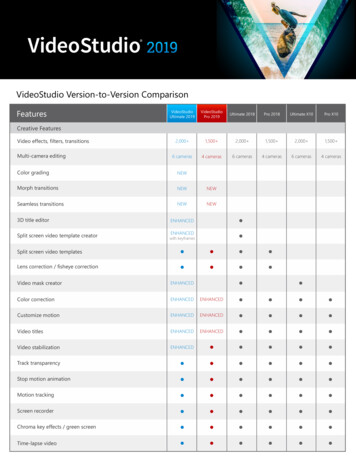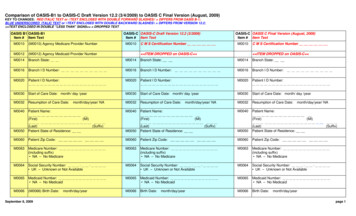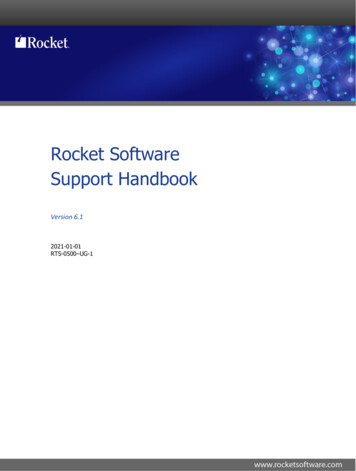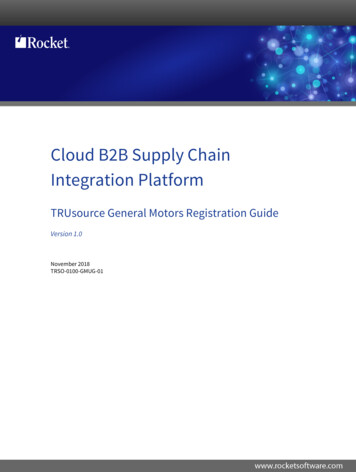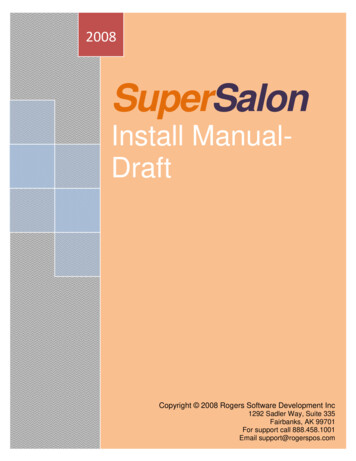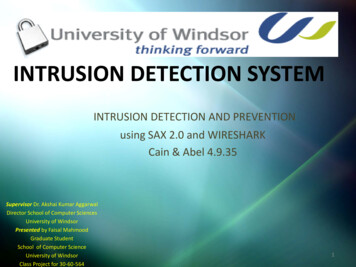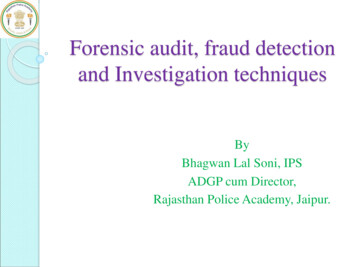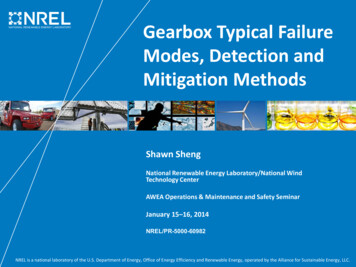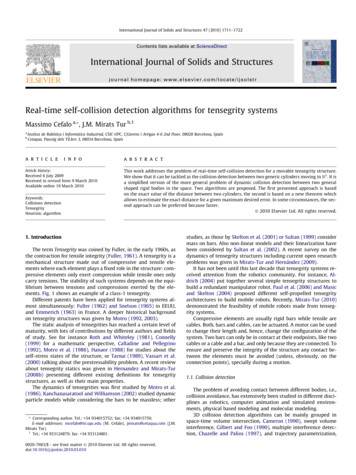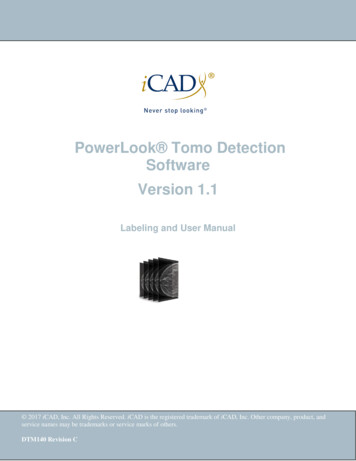
Transcription
PowerLook Tomo Detection Software Labeling and User ManualRevision CPowerLook Tomo DetectionSoftwareVersion 1.1Labeling and User ManualThis ispageintentionallyleft blank. 2017 iCAD, Inc. All Rights Reserved. iCADthe registeredtrademarkof iCAD, Inc. Other company, product, andservice names may be trademarks or service marks of others.DTM140 – Rev. CiCAD, Inc.Page 1 of 23DTM140 Revision C
PowerLook Tomo Detection Software Labeling and User ManualRevision CDTM140 – Rev. CPage 2 of 23iCAD, Inc.
PowerLook Tomo Detection Software Labeling and User ManualRevision CRegulatory Requirements:PowerLook Tomo Detection Software complies with the regulatory requirements of thefollowing: EN ISO 13485:2012 entitled Medical devices. Quality Management Systems Requirements for regulatory purposes, FDA 21 CFRPart 820 entitled Quality System Regulation (QSR). Medical Device Vigilance System MEDDEV 2.12/1 European Medical Device Directive 93/42/EEC Canadian Medical Devices Regulations SOR 98-282PowerLook Tomo DetectionSoftwareManufacturer:iCAD, Inc.98 Spit Brook Road, Suite 100Nashua, NH 03062, U.S.A.European Authorized Representative:MDSS GmbHSchiffgraben 4130175 HannoverGermanyDTM140 – Rev. CiCAD, Inc.Page 3 of 23
PowerLook Tomo Detection Software Labeling and User ManualRevision CExplanation of Symbols used marking the PowerLook Tomo Detection Software:SymbolDescriptionManufacturerDate of ManufactureRefer to ManualWARNINGWarnings are directions which, if they are not followed, can cause fatal orserious injuries to a patient or users.CAUTIONCautions are directions which, if they are not followed, can cause damage tothe equipment described in this manual.NOTENotes provide advice and highlight unusual points. A note is not intended asan instruction.CE MarkAuthorized representative in the European CommunitySNREFSerial NumberModel or Catalogue NumberCAUTION: Federal law restricts the sale, distribution, and use of this device to or on theorder of a physician.DTM140 – Rev. CiCAD, Inc.Page 4 of 23
PowerLook Tomo Detection Software Labeling and User ManualRevision CTABLE OF CONTENTS1OVERVIEW OF MANUAL .71.1234REFERENCE DOCUMENTS . 7POWERLOOK TOMO DETECTION SOFTWARE DEVICE LABELING .72.1INDICATIONS FOR USE. 72.2DEVICE DESCRIPTION . 72.3W ARNINGS . 72.4ADVERSE EFFECTS . 82.5CLINICAL STUDY . 82.5.1Study Cases . 92.5.2Study Readers .112.5.3Study Execution .132.5.4Pivotal Study Primary Results .152.5.5Pivotal Study Secondary Results .162.5.6CAD Standalone Study .172.6DETAILED DEVICE DESCRIPTION .182.7CONFORMANCE TO STANDARDS .182.8DESCRIPTION OF ACCESSORIES .182.9INSTALLATION .18RADIOLOGIST USE OF POWERLOOK TOMO DETECTION SOFTWARE .193.1GE V-PREVIEW SYNTHETIC IMAGE .193.2CAD-ENHANCED V-PREVIEW SYNTHETIC IMAGE .193.3V-PREVIEW CROSS-REFERENCE .203.4RECOMMENDED HANGING PROTOCOL FOR READING WITH CAD .21REFERENCES.22DTM140 – Rev. CiCAD, Inc.Page 5 of 23
PowerLook Tomo Detection Software Labeling and User ManualRevision CThis page intentionally left blank.DTM140 – Rev. CiCAD, Inc.Page 6 of 23
PowerLook Tomo Detection Software Labeling and User Manual1Revision COverview of ManualThis manual describes the PowerLook Tomo Detection Software and provides training toradiologists on the use of the PowerLook Tomo Detection Software.1.1 Section 2 provides the PowerLook Tomo Detection Software device labeling. Section 3 describes how a radiologist should use the PowerLook Tomo DetectionSoftware. Section 4 includes reference documentationReference Documents DTM144, PowerLook AMP Service Manual 5415896-3-1EN GE SenoClaire Operator Manual2PowerLook Tomo Detection Software Device Labeling2.1 Indications for UseThe iCAD PowerLook Tomo Detection Software is a computer-assisted detection (CAD)software device intended to be used concurrently by radiologists while reading GE Senoclairebreast tomosynthesis exams. The system detects up to five soft tissue densities (masses,architectural distortions and asymmetries) in the 3D tomosynthesis images. The detections areblended with the standard 2D synthetic image and the CAD-enhanced 2D synthetic image isviewed on a mammography review workstation.The CAD-enhanced 2D synthetic image assists radiologists in identifying densities (masses,architectural distortions and asymmetries) that may be confirmed or dismissed by the radiologistin the digital breast tomosynthesis (DBT) images.2.2Device DescriptionThe iCAD PowerLook Tomo Detection Software in conjunction with the GE SenoClaire DigitalBreast Tomosynthesis and a mammography review workstation create a CAD-enhanced 2Dsynthetic image that can allow radiologists to review tomosynthesis images more quickly with noimpact to the radiologist’s performance. The product detects soft tissue densities (masses,architectural distortions and asymmetries) in the 3D tomosynthesis images.A blendingalgorithm then processes the CAD detections from the 3D planes and merges them onto GE’sexisting 2D volume preview (“V-Preview”) synthetic image and the mammography reviewworkstation displays the CAD-enhanced 2D synthetic image.2.3Warnings Blended areas on the Enhanced V-Preview image may obscure other areas of interest thatmay have been visible on the unenhanced V-Preview image.DTM140 – Rev. CiCAD, Inc.Page 7 of 23
PowerLook Tomo Detection Software Labeling and User Manual 2.4Revision CIncorrect implementation of the CAD-enhanced synthetic image can lead to an inability toview the CAD-enhanced image or the inability to navigate into the 3D dataset using theproduct.The CAD does not detect any microcalcifications and also may miss some soft tissuedensities (masses, architectural distortions and asymmetries) so a complete review of thewhole set of images indicated by the GE Senoclaire DBT system is necessary to identifycalcifications and other breast lesions that CAD may have missed.The safety and effectiveness in patients with breast implants has not been established forviews that include the implant. When non-displaced implant views are analyzed by thesystem, the CAD enhanced V-Preview images should not be used.The safety and effectiveness of CAD has not been established for non-standardmammographic views (e.g., magnification/compression views). When these views areanalyzed by the system, the CAD enhanced V-Preview images should not be used.The safety and effectiveness of CAD has not been established for the following standardmammographic views (CC, ML, LM, SIO, XCCL, XCCM).Adverse EffectsThe PowerLook Tomo Detection Software may increase your false-positive rates for bothscreening and diagnostic mammography. Increased false-positives may lead to unnecessaryadditional imaging radiation exposure, biopsy, patient anxiety, etc.2.5Clinical StudyThe pivotal reader study used a multi-reader, multi-case (MRMC) cross-over design with anenriched sample of 240 cases and 20 tomosynthesis radiologist readers to compare clinicalperformance of radiologists using CAD-enhanced synthetic 2D V-Preview images with GE DBTimages (“with CAD”) to that of radiologists using GE DBT without CAD-enhanced 2D V-Previewimages (“without CAD”).The co-primary objectives of the pivotal reader study were to determine:1) Whether radiologist performance when using CAD with GE DBT images is non-inferior toradiologist performance when using GE DBT images without CAD, and2) Whether radiologist reading time when using CAD with GE DBT images is superior to (shorterthan) radiologist reading time when using GE DBT images without CAD.Radiologist performance was assessed by measuring Area Under the Receiver Operating Characteristic(ROC) Curve (AUC) for the detection of malignant lesions in the pivotal reader study.Successful demonstration of safety and effectiveness of using CAD with GE DBT compared to usingGE DBT without CAD was defined as:1) The lower limit of the two-sided 95% confidence interval for the difference in average AUC withCAD – without CAD lies above the negative of the non-inferiority margin, -0.05, and2) The lower limit of the two-sided 95% confidence interval for the difference in average readingtime with CAD – without CAD lies below zero, i.e., if reading time decreases.Secondary objectives of the pivotal reader study included non-inferiority and possible superiority ofradiologist sensitivity, specificity and recall rate, and possible superiority of AUC.DTM140 – Rev. CiCAD, Inc.Page 8 of 23
PowerLook Tomo Detection Software Labeling and User ManualRevision CAdditional objectives of the pivotal study were to determine the results of a CAD standaloneperformance assessment. The standalone performance assessment measured CAD performancewithout a radiologist.2.5.1 Study CasesFive-hundred and twenty-five (525) GE DBT cases meeting the inclusion and exclusion criteria forthis study were retrospectively collected from five (5) image acquisition sites. Two-hundred andforty (240) of these 525 cases were selected for the pivotal reader and standalone studies.Data from three (3) French sites were collected under iCAD’s tomosynthesis data collectionprotocol in compliance with French Data Protection Law and de-identified; informed consent waswaived by the French Data Protection Authority, Commission nationale de l'informatique et deslibertés (CNIL). Anonymized collection of existing data from two (2) US sites was performed underthe same protocol with Institutional Review Board (IRB) approval for the data collection andwaiver of informed consent.Inclusion Criteria:1. Female subjects2. Subjects 18 or more years old3. Subjects undergoing a bilateral screening or diagnostic tomosynthesis exam with GESenoclaire, which must include at least bilateral 2D Craniocaudal (CC) FFDM imagesand bilateral Mediolateral Oblique (MLO) DBT images (2D V-Preview, 3D slabs, 3Dplanes and 2D projections)4. Imaging characteristics consistent with Mammography Quality Standards Act (MQSA) interms of positioning, compression, exposure level, dose, contrast, sharpness, noise andartifacts5. Subjects with breast implants were permitted if implant-displaced views are available forthe required images: 2D CC FFDM images and MLO DBT images (2D V-Preview, 3Dslabs, 3D planes and 2D projections)6. “Regulatory” cases, which are clinical and image data that is controlled by Quality &Regulatory Affairs (QA/RA) and were blinded to R&D (i.e., unavailable to R&D)7. Recalled, Benign and Cancer cases were required to have additional mammographicviews showing the location of the lesion (e.g., magnification and/or spot compressionviews, screenshots, needle-localization or biopsy images, etc.) and/or annotations by thecontributing site radiologists outlining the lesion with the GE MammoWorkstation and/orradiology reports describing the location of the lesion for the truthing processExclusion Criteria:1. Subjects with a personal history of breast cancer2. Subjects with imaging evidence of previous surgery (e.g., surgical clips visible onimages); these women were excluded because readers were not provided patient historyor prior exams during the pivotal reader study which would have been important in theassessment of these women’s images; subjects with breast reduction surgery were notexcluded and were permittedDTM140 – Rev. CiCAD, Inc.Page 9 of 23
PowerLook Tomo Detection Software Labeling and User ManualRevision C3. “Development” cases, which are clinical and image data that were not blinded toResearch & Development (R&D) (i.e., available to R&D)All 525 cases were categorized as one of the following types: 264 Negative CasesNo BI-RADS 0, 3, 4 or 5 lesions detected by radiologist on tomosynthesis examinterpreted as BI-RADS 1 or 2 and no cancers were found. Negative cases had at leastone confirming normal tomosynthesis exam or 2D mammogram (BI-RADS 1 or 2) atleast one year (320 or more days) after the study tomosynthesis exam. 71 Recalled CasesLesion(s) detected by radiologist on screening tomosynthesis exam interpreted as BIRADS 0 where no biopsy was warranted due to subsequent negative imaging work-up.Data collection sites may not have used BI-RADS 0 if they performed an imaging workup, when needed, immediately after the screening the exam while the patient was still inthe facility. Since the patient had an immediate diagnostic work-up, a final BI-RADSassessment category was used (which does not include BI-RADS 0). Recalled caseshad at least one confirming normal tomosynthesis exam or 2D mammogram (BI-RADS 1or 2) at least one year (320 or more days) after the study tomosynthesis exam. 86 Benign CasesLesion(s) detected by radiologist on tomosynthesis exam interpreted as BI-RADS 3, 4 or5 in a patient who had a breast biopsy within one year (365 or less days) of thetomosynthesis exam that was benign. Benign lesions included high-risk lesions lobularcarcinoma in-situ, atypical ductal hyperplasia, atypical lobular hyperplasia, andpapillomas. 104 Cancer CasesLesion(s) detected by radiologist on tomosynthesis exam interpreted as BI-RADS 3, 4, or5 in a patient who had a breast biopsy within one year (365 or less days) of thetomosynthesis exam that was malignant. Malignant lesions did not include high-risklesions including lobular carcinoma in-situ, atypical ductal hyperplasia, atypical lobularhyperplasia and papillomas.Each case was truthed by one “expert” breast imaging radiologist. The same individual truthingradiologist truthed every case. The reference standard for Cancer and Benign cases was biopsyproof. The reference standard for Recalled cases was BI-RADS 0 without biopsy and normalimaging at least one year (320 or more days inclusive) later. The reference standard for Negativecases was normal one-year follow-up imaging (320 or more days inclusive).The 240 cases for the pivotal reader and standalone studies were selected from the 525 caseseligible for the studies. The 240 cases were randomly selected with a stratification tool to meet thestratification targets based on the case and lesion characteristics established by the truthingprocess. All required targets were met. Case and lesion characteristics for the 240 selected casesare shown in Table 1. Selected cases were from women aged 29 – 86 with a median age of 57(interquartile range 49 – 64) and a mean age of 56.5 (standard deviation 10.8).DTM140 – Rev. CiCAD, Inc.Page 10 of 23
PowerLook Tomo Detection Software Labeling and User ManualRevision CTable 1: Stratified DatasetCase Characteristic Criteria240 SelectedCasesPatient CriteriaBreast density Almost entirely fatty or scattered areas of fibroglandular density Heterogeneously dense or Extremely dense breasts121/240 (50.4%)119/240 (49.6%)Negative Cases CriteriaBI-RADS 1 or 2: not suspicious, no recall, no biopsy, not cancer102/240 (42.5%) BI-RADS 175/102 (73.5%) BI-RADS 227/102 (26.5%)Recalled Cases CriteriaBI-RADS 0: suspicious, recall, but no biopsy warranted20/240 (8.3%) Soft tissue densitieso Soft tissue densities and calcifications16/20 (80.0%)1/20 (5.0%) Calcifications only4/20 (20.0%)Benign Cases CriteriaBI-RADS 3, 4 or 5: suspicious, recall, biopsy-proven benign, not cancer57/240 (23.8%) Soft tissue densitieso Soft tissue densities and calcifications40/57 (70.2%)5/57 (8.8%) Calcifications only17/57 (29.8%)Cancer Cases CriteriaBI-RADS 3, 4 or 5: suspicious, recall, biopsy-proven cancer61/240 (25.4%) Soft tissue densitieso Soft tissue densities and calcifications48/61 (78.7%)9/61 (14.8%) Calcifications only13/61 (21.3%) Invasive cancer (all 2.5 cm in size)o Proportion 1.4 cm in sizeo Proportion invasive lobular cancer50/61 (82.0%)27/50 (54.0%)7/50 (14.0%) DCIS (no size restriction)11/61 (18.0%)2.5.2 Study ReadersAll 20 readers had American Board of Radiology certification, qualified to interpret mammogramsunder MQSA and had completed eight hours of initial training in breast tomosynthesis as requiredby the FDA. Readers were currently reading tomosynthesis exams, having interpreted more than500 tomosynthesis exams in the last two years.DTM140 – Rev. CiCAD, Inc.Page 11 of 23
PowerLook Tomo Detection Software Labeling and User ManualRevision CReaders had a range of experience in the interpretation of breast images with 55% (11/20) ofreaders devoting less than 75% of their professional time to breast imaging for the last 3 yearsand 45% (9/20) devoting 75% or more of their professional time to breast imaging for the last 3years. Additional reader characteristics are provided in Table 2. None of the readers wereinvolved with acquisition of any of the study cases.Table 2: Summary of Study Reader Experience: N (%) unless otherwise notedRadiologists (N 20)Years in PracticeMedian (IQR)14.5 (8.0 - 20.5)Range1.0 - 43.0Mean (SD)15.45 (10.86)Specialized Mammography TrainingYes5 (25)No15 (75)Average Hours Spent in a Clinical Day71 (5)82 (10)91 (5)9.516 (80)75% or More of Professional Time Devoted to Breast Imaging for the Last 3 YearsYes9 (45)No11 (55)IQR interquartile range, 25th percentile through 75th percentile. SD standard deviation.Readers did not participate in the truthing process for any of the pivotal reader or standalone studycases.Readers were trained on the reading procedures of this study with 30 tomosynthesis cases. Sincethe readers were fully certified to interpret tomosynthesis exams and were currently readingtomosynthesis exams in their clinical practices, no additional tomosynthesis interpretation trainingwas provided. The training provided to the readers in the study focused on use of the CADenha
Software. Section 4 includes reference documentation . 1.1 Reference Documents DTM144, PowerLook AMP Service Manual 5415896-3-1EN GE SenoClaire Operator Manual . 2 PowerLook Tomo Detection Software Device Labeling 2.1 Indications for Use The iCAD PowerLook Tomo Detection -assiste


